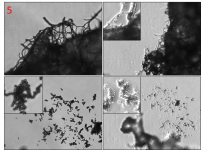Title edited for brevity. This is the complete orginal:
[REFERENCE] Things I Found in My Tobacco - Episode 1 - Acadian Gold (Perique Method)
[INTRODUCTION] Inspired by a recent inquiry into some white 'growths' in a tin of Robert McConnell Perique, I thought I would take a look around in my own cellar. I was sure I'd seen them before so I thought it would be worth a closer looks. A much, much closer look. I found them on various tobaccos I have in jars, but one place where they were very prevalent was inside a tin of a personal favorite---Russ Ouellette's Acadian Gold. Acadian Gold, a "love-hate" tobacco, is a "bright, sweet, yellow, Canadian-grown Virginia" that has undergone a Perique processing and the resulting leaf is rich and complex. My open tin of Acadian Gold has an astounding number of these white 'growths' in and on it, and it also appears on the paper cover that sits atop the tobacco.
[DISCLAIMER] Before I proceed I must offer a disclaimer insofar as the analysis that follows extends only to my own tobacco. I have not, unfortunately, been able to analyze the 'growths' in your tobacco and thus cannot be as certain about the identity of your gremlins as I am about my own. Onward...
The Acadian Gold (left) and closeup of the tobacco dandruff. What is that stuff?
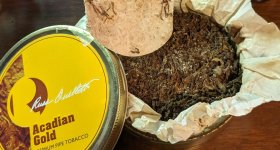
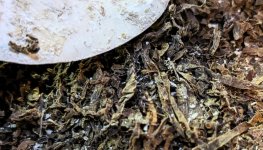
So I did what anyone would do. I took some samples into the lab for further analysis. Any good analysis must include both positive and negative controls. In this case, working under the assumption that what concerns most pipe smokers is the contamination of their tobacco by fungus, I would need a suitable example of a common household mold for purposes of comparison. On this occasion what I had on hand for a casual investigation were (left):
1. Some Esoterica Dorchester--uncontaminated (apparently)--as a negative control
2. Some Acadian Gold, with obvious crust of white stuff--the object of our investigation
3. White stuff picked out from among the ribbons of tobacco--a few stray flakes included
4. White stuff scraped off the paper insert
5. Household mold scraped off a bagel we forgot about in the cupboard--white and blue patches
6. A thin slice of bagel where apparently nothing was growing
7 & 8. Some tea leaves I also forgot about and that had plenty of mold
The samples were loaded into wells of a plastic plate that would be suitable for further treatment and investigation (right):
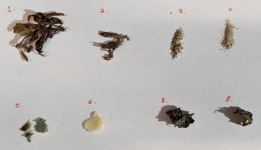
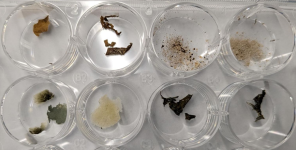
Much of what there is to be learned about the identity of things in the laboratory can be gleaned from careful observation at high magnification for evaluation of structure and morphology. In this case an initial inspection by light microscopy at 4x and 20x magnificaiton would be suitable:
Comparison of samples #1 and #2 were consistent with dried plant material and cellulose matrix. The appearance of the samples (to borrow an expression from pathologists) was otherwise unremarkable (nothing "stood out" as being distinct or abnormal).
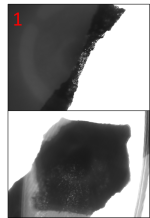
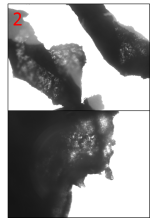
The 'white stuff' was, unsurprisingly, considerably different than its vegetal substrate (#3a). At lower magnifications (4x) the sample had a rocky, gravel appearance. Upon closer inspection (20x) it was possible to discern fine crystalline needles. These had the appearance of being somewhat fragile which would explain why some of the larger aggregates appeared rocky and dull.
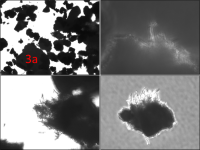
These crystals were insoluble in phosphate buffered saline at pH7.0 (#3b; RGB brighfield microscopy), however they readily dissolved in a sodium acetate pH4.75 solution (#3c) leaving behind only pieces of tobacco leaf, suggesting the possibility that they are an organic salt. More conclusive tests would certainly give a more conclusive answer in terms of the chemical composition of the crystals. I leave conjecture to others but I would be surprised if the crystals aren't in fact something that was itself sprayed or otherwise applied to the tobacco during its processing. Occam's razor...
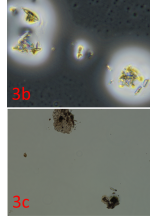
What about the bagel? Don't forget the bagel! I didn't forget the bagel. A positive control is essential to any half-assed scientific endeavor. What types of things would we be looking for in the case of a fungal infection of tobacco? For starters we focus on fungal infections because the moisture content and the format (solid) of the tobacco was insufficient to support bacterial growth to any extent. The villain in most cases tends to be fungi that quickly colonize tobacco within an acceptable range of moisture conditions, spreading their filamentous tendrils (hyphae) throughout, secreting enzymes to essentially digest their substrate (our bagels, our tobaccos) and reabsorb their meals.
The bagel (#5) is a perfect example of fungal contamination, having very promiment filamentous hyphae and spores (conidia). The slice of bagel that wasn't contaminated (#6) actually only wasn't visibly contaminated. I did ultimately find a few hyphae in the sample. What most of us see on moldy bread is usually the spores at the surface. In this case, the hyphae underneath had already spread.
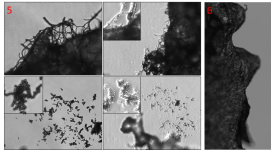
And the teas (#7 & 8)---the stereotypical morphology of Aspergillus sp. is very prominent. The conidiophore and conidia chains--delicate structures.
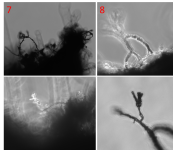
In order to investigate the samples a little further, I decided to probe them using two molecular probes that stain DNA (a dye called Hoeschst 33342), and a fluorescently-linked phalloidin (a fungal toxin that binds filamentous actin). These two stains would give a higher-magnification readout of any DNA and actin (cytoskeleton, a cell's "structure") that might be present in the samples.
As shown (below) all of the fungally-contaminated samples had prominent staining for both hyphae and conidia. I was happy that the images were similar to those reported elsewhere [LINK] by researchers using the same probes.
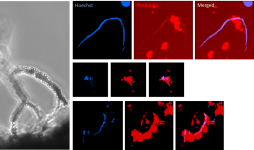
The "shake" containing the crystals and tobacco pieces had no such fungal structures. There were "clumps" of DNA and actin staining but because these were not organized into structures, they were likely from the tobacco itself. In fact, although I didn't save the photo, it turns out that wheat flour is FULL of DNA. The photo wasn't very interesting---a glowing blue bagel slice.
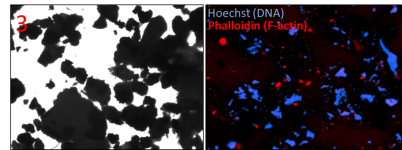
In summary, the white gremlins growing on my perique-processed Acadian Gold are likely organic crystals and not fungal spores. And while it's not possible for everyone to undertake this type of analysis at home, an easy test would be to collect the crystals and see if they dissolve in simple household vinegar. If they dissolve they are very unlikely to be fungal in origin.
@hamid
[REFERENCE] Things I Found in My Tobacco - Episode 1 - Acadian Gold (Perique Method)
[INTRODUCTION] Inspired by a recent inquiry into some white 'growths' in a tin of Robert McConnell Perique, I thought I would take a look around in my own cellar. I was sure I'd seen them before so I thought it would be worth a closer looks. A much, much closer look. I found them on various tobaccos I have in jars, but one place where they were very prevalent was inside a tin of a personal favorite---Russ Ouellette's Acadian Gold. Acadian Gold, a "love-hate" tobacco, is a "bright, sweet, yellow, Canadian-grown Virginia" that has undergone a Perique processing and the resulting leaf is rich and complex. My open tin of Acadian Gold has an astounding number of these white 'growths' in and on it, and it also appears on the paper cover that sits atop the tobacco.
[DISCLAIMER] Before I proceed I must offer a disclaimer insofar as the analysis that follows extends only to my own tobacco. I have not, unfortunately, been able to analyze the 'growths' in your tobacco and thus cannot be as certain about the identity of your gremlins as I am about my own. Onward...
The Acadian Gold (left) and closeup of the tobacco dandruff. What is that stuff?


So I did what anyone would do. I took some samples into the lab for further analysis. Any good analysis must include both positive and negative controls. In this case, working under the assumption that what concerns most pipe smokers is the contamination of their tobacco by fungus, I would need a suitable example of a common household mold for purposes of comparison. On this occasion what I had on hand for a casual investigation were (left):
1. Some Esoterica Dorchester--uncontaminated (apparently)--as a negative control
2. Some Acadian Gold, with obvious crust of white stuff--the object of our investigation
3. White stuff picked out from among the ribbons of tobacco--a few stray flakes included
4. White stuff scraped off the paper insert
5. Household mold scraped off a bagel we forgot about in the cupboard--white and blue patches
6. A thin slice of bagel where apparently nothing was growing
7 & 8. Some tea leaves I also forgot about and that had plenty of mold
The samples were loaded into wells of a plastic plate that would be suitable for further treatment and investigation (right):


Much of what there is to be learned about the identity of things in the laboratory can be gleaned from careful observation at high magnification for evaluation of structure and morphology. In this case an initial inspection by light microscopy at 4x and 20x magnificaiton would be suitable:
Comparison of samples #1 and #2 were consistent with dried plant material and cellulose matrix. The appearance of the samples (to borrow an expression from pathologists) was otherwise unremarkable (nothing "stood out" as being distinct or abnormal).


The 'white stuff' was, unsurprisingly, considerably different than its vegetal substrate (#3a). At lower magnifications (4x) the sample had a rocky, gravel appearance. Upon closer inspection (20x) it was possible to discern fine crystalline needles. These had the appearance of being somewhat fragile which would explain why some of the larger aggregates appeared rocky and dull.

These crystals were insoluble in phosphate buffered saline at pH7.0 (#3b; RGB brighfield microscopy), however they readily dissolved in a sodium acetate pH4.75 solution (#3c) leaving behind only pieces of tobacco leaf, suggesting the possibility that they are an organic salt. More conclusive tests would certainly give a more conclusive answer in terms of the chemical composition of the crystals. I leave conjecture to others but I would be surprised if the crystals aren't in fact something that was itself sprayed or otherwise applied to the tobacco during its processing. Occam's razor...

What about the bagel? Don't forget the bagel! I didn't forget the bagel. A positive control is essential to any half-assed scientific endeavor. What types of things would we be looking for in the case of a fungal infection of tobacco? For starters we focus on fungal infections because the moisture content and the format (solid) of the tobacco was insufficient to support bacterial growth to any extent. The villain in most cases tends to be fungi that quickly colonize tobacco within an acceptable range of moisture conditions, spreading their filamentous tendrils (hyphae) throughout, secreting enzymes to essentially digest their substrate (our bagels, our tobaccos) and reabsorb their meals.
The bagel (#5) is a perfect example of fungal contamination, having very promiment filamentous hyphae and spores (conidia). The slice of bagel that wasn't contaminated (#6) actually only wasn't visibly contaminated. I did ultimately find a few hyphae in the sample. What most of us see on moldy bread is usually the spores at the surface. In this case, the hyphae underneath had already spread.

And the teas (#7 & 8)---the stereotypical morphology of Aspergillus sp. is very prominent. The conidiophore and conidia chains--delicate structures.

In order to investigate the samples a little further, I decided to probe them using two molecular probes that stain DNA (a dye called Hoeschst 33342), and a fluorescently-linked phalloidin (a fungal toxin that binds filamentous actin). These two stains would give a higher-magnification readout of any DNA and actin (cytoskeleton, a cell's "structure") that might be present in the samples.
As shown (below) all of the fungally-contaminated samples had prominent staining for both hyphae and conidia. I was happy that the images were similar to those reported elsewhere [LINK] by researchers using the same probes.

The "shake" containing the crystals and tobacco pieces had no such fungal structures. There were "clumps" of DNA and actin staining but because these were not organized into structures, they were likely from the tobacco itself. In fact, although I didn't save the photo, it turns out that wheat flour is FULL of DNA. The photo wasn't very interesting---a glowing blue bagel slice.

In summary, the white gremlins growing on my perique-processed Acadian Gold are likely organic crystals and not fungal spores. And while it's not possible for everyone to undertake this type of analysis at home, an easy test would be to collect the crystals and see if they dissolve in simple household vinegar. If they dissolve they are very unlikely to be fungal in origin.
@hamid
Attachments
Last edited by a moderator:





